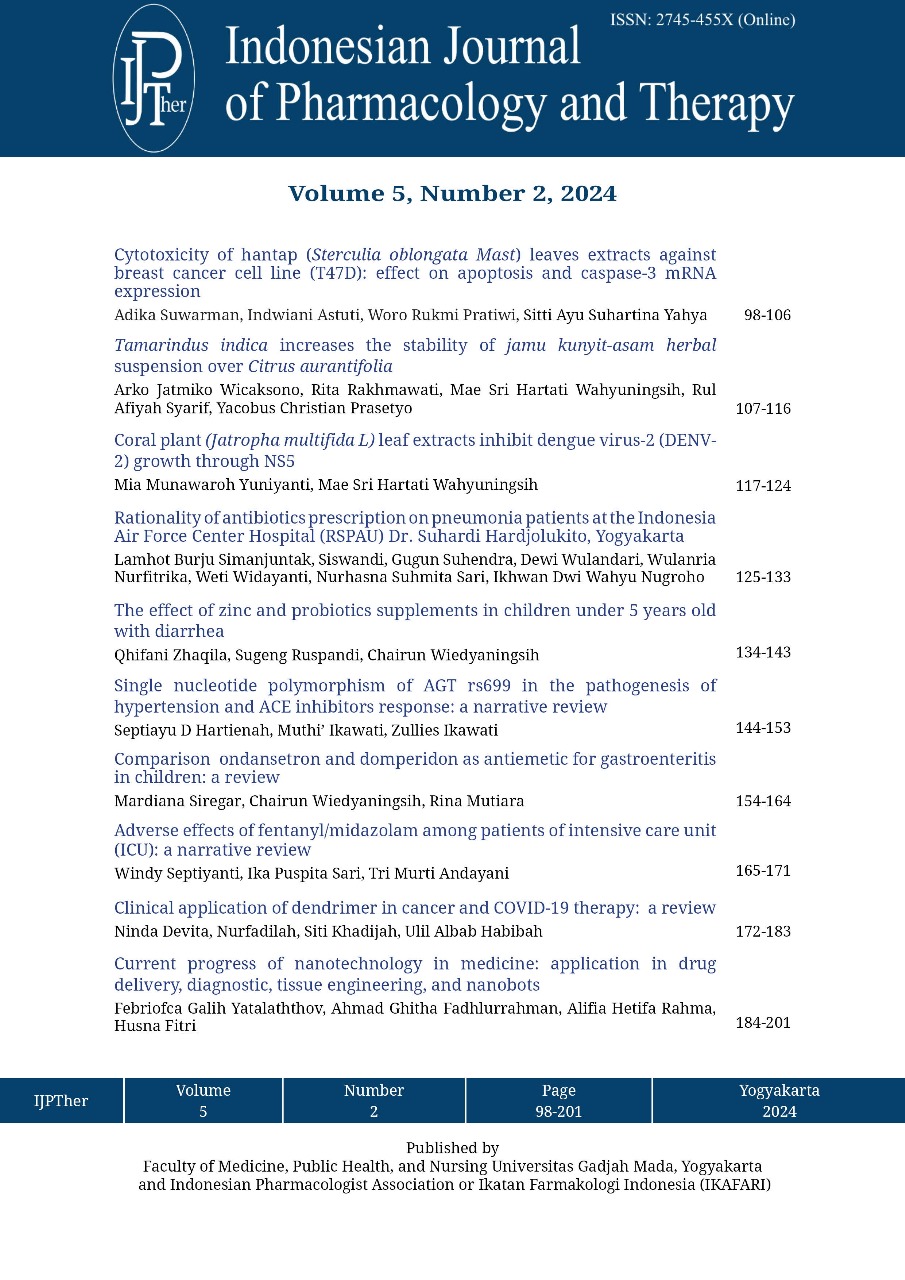Adverse effects of fentanyl/midazolam among patients of intensive care unit (ICU): a narrative review
Abstract
Patients of intensive care unit (ICU) have a complicated condition due to disease, comorbid, and other risk factors. Some ICU patients need to get an invasive process to reduce pain, anxiety, and support their condition. During an invasive process, including mechanical ventilation which causes pain or anxiety, the patient is given
sedative and analgesic agents to support the procedure and reduce the patient’s pain and anxiety. However, the use of fentanyl/midazolam has the potential to cause adverse effects, for instance, hypotension, hypoxia, and delirium in several ICU patients. Several risk factors that can lead to adverse effects are aging, obesity, underlying cardiac disease, and the amount of dosage. Therefore, it is essential to recognize the risk factors and monitor the use of fentanyl/midazolam to prevent the worsening condition of patients.
References
AACN Scope and Standards for Progressive and Critical Care Nursing Practice - AACN [Internet]. [cited 2023 Nov 14].
Parrillo JE, Dellinger RP. Critical care medicine: principles of diagnosis and management in the adult [Internet]. 4th ed. Philadelphia, PA: Elsevier/Saunders; 2014 [cited 2023 Nov 14]. 1490 p.
https://expertconsult.inkling.com/
Rahma AW, Ismail S. Gambaran Pengetahuan Perawat Tentang Intervensi Mandiri Ventilator Associated Pneumonia Bundle Care Pada Pasien Dengan Ventilasi Mekanik di Unit Perawatan Intensif. Jurnal Perawat Indonesia. 2019 May 25; 3:1-7.
https://doi.org/10.32584/jpi.v3i1.69
Patel SB, Kress JP. Sedation and analgesia in the mechanically ventilated patient. Am J Respir Crit Care Med 2012; 185(5):486-97.
https://doi.org/10.1164/rccm.201102-0273CI
Mason KP, Green SM, Piacevoli Q. Adverse event reporting tool to standardize the reporting and tracking of adverse events during procedural sedation: a consensus document from the World SIVA International Sedation Task Force. Br J Anaesth 2012; 108(1):13-20.
https://doi.org/10.1093/bja/aer407
Lisha J, Annalakshmi V, Maria J, Padmini D. Adverse Drug Reactions in Critical Care Settings: A Systematic Review. Curr Drug Saf 2017; 12(3):147-61.
https://doi.org/ 10.2174/1574886312666170710192409
Bellolio MF, Gilani WI, Barrionuevo P, Murad MH, Erwin PJ, Anderson JR, et al. Incidence of Adverse Events in Adults Undergoing Procedural Sedation in the Emergency Department: A Systematic Review and Meta‐analysis. Acad Emerg Med 2016; 23(2):119-34.
https://doi.org/10.1111/acem.12875
Lee B, Park JD, Choi YH, Han YJ, Suh DI. Efficacy and Safety of Fentanyl in Combination with Midazolam in Children on Mechanical Ventilation. J Korean Med Sci 2019; 34(3):e21.
https://doi.org/10.3346/jkms.2019.34.e21
Okumura Y, Sato Boku A, Tachi N, Kanazawa M, Kawabata M, Okuda M. Usefulness of Continuous Low-Dose Fentanyl in Combination with Dexmedetomidine and Midazolam for Intravenous Sedation: A Randomised Controlled Trial. Biomed Res Int 2022; 2022:2807581.
https://doi.org/10.1155/2022/2807581
Selvaraj RJ, Dukiya S, Ananthakrishna Pillai A, Satheesh S, Balachander J. Effects of conscious sedation on tachycardia inducibility and patient comfort during ablation of supraventricular tachycardia: a double blind randomized controlled study. Europace 2019; 21(1):142-6.
https://doi.org/10.1093/europace/euy146
Liu D, Lyu J, Zhao H, An Y. The influence of analgesic-based sedation protocols on delirium and outcomes in critically ill patients: A randomized controlled trial. PLoS One 2017; 12(9):e0184310.
https://doi.org/10.1371/journal.pone.0184310
Gulla KM, Sankar J, Jat KR, Kabra SK, Lodha R. Dexmedetomidine vs Midazolam for Sedation in Mechanically Ventilated Children: A Randomized Controlled Trial. Indian Pediatr 2021; 58(2):117-22.
Ramos-Matos CF, Bistas KG, Lopez-Ojeda W. Fentanyl. In: StatPearls. Treasure Island (FL): StatPearls Publishing; 2023.
http://www.ncbi.nlm.nih.gov/books/NBK459275/
Lingamchetty TN, Hosseini SA, Saadabadi A. Midazolam. In: StatPearls. Treasure Island (FL): StatPearls Publishing; 2023.
from: http://www.ncbi.nlm.nih.gov/books/NBK537321/
Devlin JW, Skrobik Y, Gélinas C, Needham DM, Slooter AJC, Pandharipande PP, et al. Clinical Practice Guidelines for the Prevention and Management of Pain, Agitation/Sedation, Delirium, Immobility, and Sleep Disruption in Adult Patients in the ICU. Crit Care Med 2018; 46(9):e825-73.
https://doi.org/10.1097/CCM.0000000000003299
Roberts DJ, Haroon B, Hall RI. Sedation for critically ill or injured adults in the intensive care unit: a shifting paradigm. Drugs 2012; 72(14):1881-916.
https://doi.org/10.2165/11636220-000000000-00000
Miller M, Groombridge CJ, Lyon R. Haemodynamic changes to a midazolam–fentanyl–rocuronium protocol for pre-hospital anaesthesia following return of spontaneous circulation after cardiac arrest. Anaesthesia 2017; 72(5):585-91.
https://doi.org/ 10.1111/anae.13809
Song SY, Son SH, Kim SO, Roh WS. Intravenous fentanyl during shoulder arthroscopic surgery in the sitting position after interscalene block increases the incidence of episodes of bradycardia hypotension. Korean J Anesthesiol 2011; 60(5):344-50.
https://doi.org/10.4097/kjae.2011.60.5.344
van den Broek MPH, van Straaten HLM, Huitema ADR, Egberts T, Toet MC, de Vries LS, et al. Anticonvulsant Effectiveness and Hemodynamic Safety of Midazolam in Full-Term Infants Treated with Hypothermia. Neonatology 2015; 107(2):150-6.
https://doi.org/10.1159/000368180
Win NN, Fukayama H, Kohase H, Umino M. The different effects of intravenous propofol and midazolam sedation on hemodynamic and heart rate variability. Anesth Analg 2005; 101(1):97-102, table of contents.
https://doi.org/10.1213/01.ANE.0000156204.89879.5C
Shi HJ, Yuan RX, Zhang JZ, Chen JH, Hu AM. Effect of midazolam on delirium in critically ill patients: a propensity score analysis. J Int Med Res 2022; 50(4):03000605221088695.



